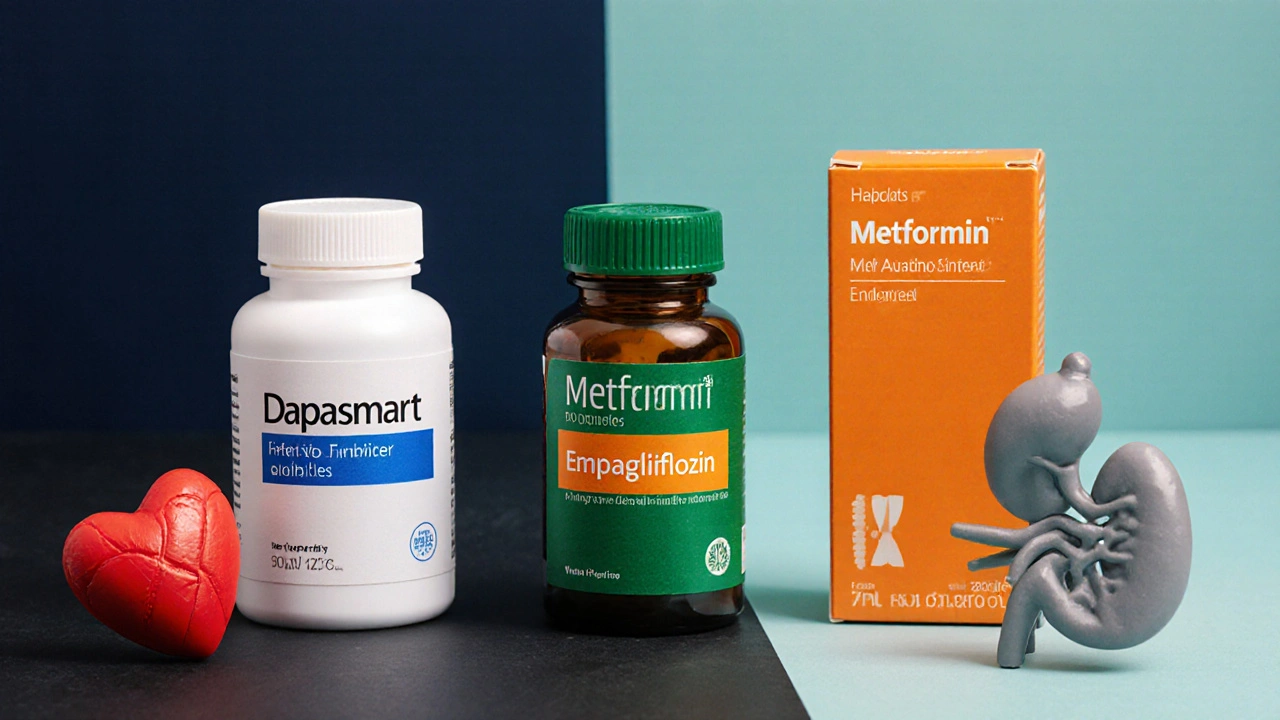Dapasmart vs Alternatives: Drug Comparison Tool
Comparison Summary
SGLT2 Inhibitor
Dosage: 10 mg daily
HbA1c Reduction: 0.5–0.8%
CV Benefit: ↓12% MACE, ↓27% HF hospitalization
Renal Benefit: ↓30% eGFR decline
Side Effects:
- Genital infections
- Volume depletion
SGLT2 Inhibitor
Dosage: 10–25 mg daily
HbA1c Reduction: 0.5–0.9%
CV Benefit: ↓14% cardiovascular death
Renal Benefit: ↓28% kidney disease progression
Side Effects:
- Genital infections
- Ketoacidosis (rare)
SGLT2 Inhibitor
Dosage: 100 mg daily (max 300 mg)
HbA1c Reduction: 0.6–1.0%
CV Benefit: ↓10% MACE
Renal Benefit: ↓25% eGFR decline
Side Effects:
- Amputation risk
- Genital infections
Biguanide
Dosage: 500–2000 mg daily
HbA1c Reduction: 0.6–1.2%
CV Benefit: Neutral
Renal Benefit: Neutral/modest
Side Effects:
- GI upset
- Lactic acidosis (rare)
GLP-1 Agonist
Dosage: 0.5–1 mg weekly
HbA1c Reduction: ≈1.5%
CV Benefit: ↓22% MACE, ↓26% HF hospitalization
Renal Benefit: ↓35% ESRD progression
Side Effects:
- Nausea, vomiting
- Pancreatitis risk
Key Recommendations
- 1.Start with metformin
- 2.Add SGLT2 inhibitor for CV/Kidney protection
- 3.Consider GLP-1 agonist for weight loss
- 4.Check eGFR before starting therapy
- 5.Monitor for side effects regularly
Important Notes
For eGFR < 45 mL/min/1.73 m²: Dapasmart and other SGLT2 inhibitors should be avoided due to decreased effectiveness.
For Cardiovascular Disease: Empagliflozin and Semaglutide offer superior CV benefits.
For Weight Loss: GLP-1 agonists provide 5–10 kg average weight loss compared to SGLT2 inhibitors (~2 kg).
When treating type 2 diabetes, Dapasmart is the brand name for dapagliflozin, an SGLT2‑inhibitor that lowers blood glucose by increasing urinary glucose excretion. If you’re trying to decide whether Dapasmart is right for you, this guide will clear things up by comparing it to the most common alternatives on the market today.
Key Takeaways
- Dapasmart belongs to the SGLT2‑inhibitor class and offers proven cardiovascular and renal benefits.
- Empagliflozin and canagliflozin share the same mechanism but differ in dosage options and side‑effect profiles.
- Metformin remains the first‑line oral agent; it works via a completely different pathway (AMPK activation).
- GLP‑1 agonists such as semaglutide provide strong weight loss and heart‑failure protection but require injection.
- Choosing the best drug hinges on kidney function, heart‑disease risk, cost, and patient preference.
What Is Dapasmart (Dapagliflozin)?
Dapagliflozin works by blocking the sodium‑glucose co‑transporter‑2 (SGLT2) in the kidney’s proximal tubules. This blockage stops glucose from being re‑absorbed, so excess sugar is flushed out in the urine. The result is a modest drop in HbA1c (about 0.5‑0.8%), reduced body weight (≈2kg on average), and lower blood pressure.
The typical dose of Dapasmart is 10mg once daily, taken with or without food. For patients with an eGFR (estimated glomerular filtration rate) of at least 45mL/min/1.73m², the drug is safe and effective; below that threshold the efficacy falls off and the label recommends dose reduction or discontinuation.
Beyond glucose control, large cardiovascular outcome trials (e.g., DECLARE‑TIMI58) demonstrated that dapagliflozin cuts the risk of major adverse cardiovascular events (MACE) by 12% and heart‑failure hospitalization by 27% in people with type 2 diabetes. The same study showed a 30% slower decline in kidney function for those with chronic kidney disease.

The Main Alternatives
When doctors talk about “alternatives,” they usually mean other drugs that sit in the same therapeutic class or are considered first‑line agents. Below is a quick snapshot of each.
- Empagliflozin (brand: Jardiance) - another SGLT2‑inhibitor with slightly stronger evidence for reducing cardiovascular death.
- Canagliflozin (brand: Invokana) - SGLT2‑inhibitor that also shows a modest benefit for slowing kidney disease progression, but carries a higher risk of lower‑limb amputation.
- Metformin - the classic first‑line biguanide; lowers hepatic glucose production via AMPK activation and improves insulin sensitivity.
- Semaglutide (brand: Ozempic/Wegovy) - a GLP‑1 receptor agonist injected weekly, known for strong HbA1c drops (≈1.5%) and significant weight loss.
Head‑to‑Head Comparison
| Drug | Class | Typical Dose | HbA1c Reduction | Cardiovascular Benefit | Renal Benefit | Common Side Effects |
|---|---|---|---|---|---|---|
| Dapasmart | SGLT2‑inhibitor | 10mg daily | 0.5‑0.8% | ↓12% MACE, ↓27% heart‑failure hospitalization | ↓30% eGFR decline | Genital infections, mild volume depletion |
| Empagliflozin | SGLT2‑inhibitor | 10‑25mg daily | 0.5‑0.9% | ↓14% cardiovascular death | ↓28% kidney disease progression | Genital infections, ketoacidosis (rare) |
| Canagliflozin | SGLT2‑inhibitor | 100mg daily (max 300mg) | 0.6‑1.0% | ↓10% MACE | ↓25% eGFR decline | Amputation risk, genital infections |
| Metformin | Biguanide | 500‑2000mg daily in divided doses | 0.6‑1.2% | No proven CV benefit, neutral | Neutral or modest renal protection | GI upset, lactic acidosis (rare) |
| Semaglutide | GLP‑1 agonist | 0.5‑1mg weekly injection | ≈1.5% | ↓22% MACE, ↓26% heart‑failure hospitalization | ↓35% progression to ESRD | Nausea, vomiting, possible pancreatitis |

How to Pick the Right Drug for You
Choosing isn’t just about numbers on a chart; it’s about matching the drug to a patient’s health story.
- Kidney function: If eGFR is below 45, dapagliflozin and other SGLT2‑inhibitors lose potency; metformin may still be an option down to 30mL/min with dose adjustment.
- Heart disease: Patients with established atherosclerotic cardiovascular disease (ASCVD) get the most mileage from empagliflozin or semaglutide, both of which shave a few more points off mortality.
- Weight concerns: SGLT2‑inhibitors give modest weight loss; GLP‑1 agonists deliver 5‑10kg on average.
- Risk of genital infections: This class (including Dapasmart) can cause yeast infections, especially in women with a history of recurrent UTIs.
- Cost and insurance coverage: Generic metformin is the cheapest. Branded SGLT2‑inhibitors and GLP‑1 agonists often require prior‑auth; checking formulary status early saves headaches.
In practice, many clinicians start with metformin, add an SGLT2‑inhibitor like Dapasmart for added heart‑kidney protection, and reserve GLP‑1 agonists for those who need aggressive weight loss or have very high HbA1c.
Practical Prescribing Tips
- Confirm baseline eGFR and liver enzymes before initiation.
- Educate patients on the “sweet urine” effect - it’s normal and usually harmless.
- Advise adequate hydration to lower the chance of volume‑depletion symptoms.
- Schedule a follow‑up A1c check in 3months and repeat eGFR assessment at 6months.
- If genital infection occurs, treat promptly and consider temporary drug pause.
- For patients on insulin or sulfonylureas, reduce those doses to avoid hypoglycemia once the SGLT2‑inhibitor kicks in.
Remember, the goal isn’t just to lower glucose; it’s to keep the heart, kidneys, and overall quality of life intact.
Frequently Asked Questions
Can I take Dapasmart if I’m already on metformin?
Yes. The combination is common because metformin tackles hepatic glucose output while Dapasmart removes glucose via the kidneys. Most guidelines recommend adding the SGLT2‑inhibitor when metformin alone can’t hit the HbA1c target.
What if my eGFR drops below 45mL/min?
Dapasmart is not recommended below that threshold because its glucose‑lowering effect diminishes. Switch to a dose‑adjusted metformin or consider a GLP‑1 agonist, which remains effective in lower kidney function.
Is the risk of ketoacidosis higher with Dapasmart?
Euglycemic ketoacidosis is rare but documented with all SGLT2‑inhibitors. It’s more likely in patients who are fasting, on a very low‑carb diet, or have acute illness. If you feel nausea, vomiting, or breathlessness, contact your doctor immediately.
How does Dapasmart compare cost‑wise to empagliflozin?
Both are branded and usually priced similarly in the US and Europe. In New Zealand, the government’s PHARMAC program may subsidize one over the other depending on the year’s budget. Always check your local formulary.
Can Dapasmart be used in type 1 diabetes?
No. SGLT2‑inhibitors are approved only for type 2 diabetes. In type 1 patients they increase the risk of ketoacidosis without proven benefit.

Amanda Joseph
October 6, 2025 AT 15:16Oh great, another SGLT2‑inhibitor hype.
Kevin Aniston
October 6, 2025 AT 16:40Honestly, the data behind Dapasmart is pretty solid and it’s great to see a drug that tackles both glucose and cardiovascular outcomes. The DECLARE‑TIMI58 trial gave us a clear picture that a 12% reduction in MACE is nothing to scoff at. I also appreciate how the renal benefit translates to a slower eGFR decline, which means preserving kidney function longer. For patients already on metformin, adding Dapasmart can be a game‑changer in hitting that HbA1c target without causing hypoglycemia. Plus, the modest weight loss and blood pressure reduction are nice added bonuses that contribute to overall health improvement. The safety profile is acceptable, with genital infections being the most common issue, but those are usually manageable with proper hygiene and education. It’s also worth noting that the drug is taken once daily, which boosts adherence compared to more complex regimens. Overall, Dapasmart offers a well‑rounded approach for many type 2 diabetes patients who need extra cardiovascular and renal protection.
kiran kumar
October 6, 2025 AT 16:41yeah sure the hype is real but dont forget the ketoacidosis risk it’s rare but still there and genital infections arent the only problem also cost can be a barrier for many patients so maybe not the best first choice for everyone
Brian Johnson
October 6, 2025 AT 17:46I’ve seen a lot of patients start on metformin and then add an SGLT2 inhibitor when the numbers don’t move enough. In my practice, Dapasmart works well when eGFR is above 45, and we keep a close eye on hydration. The side‑effect profile is relatively mild, but I always counsel about the urinary glucose and potential yeast infections. Overall, it’s a useful tool in the toolbox for those who need extra heart‑kidney protection.
Jessica Haggard
October 6, 2025 AT 19:10Let’s be clear: if your primary goal is to protect the heart and kidneys, Dapasmart is a solid pick. It’s not just about lowering blood sugar; the cardiovascular mortality benefit really sets it apart. For patients with ASCVD, the added reduction in HF hospitalizations can make a huge difference in quality of life. We do have to watch for genital infections, but a quick pop‑quiz on hygiene usually solves that. Bottom line, I’d put Dapasmart high on the list for anyone who matches the eGFR criteria.
Alan Clark
October 6, 2025 AT 20:33Wow, the comparison chart is super helpful! I’m curious how the cost compares across different regions, especially for folks without good insurance. Also, the weight loss with GLP‑1 agonists looks impressive if that’s a priority.
Mark Anderson
October 6, 2025 AT 20:35Great questions! Cost can definitely be a game‑changer – many insurers will favor one branded SGLT2‑inhibitor over another based on negotiated pricing, so it’s worth checking the formulary. If you’re looking for weight loss, the GLP‑1 agents really shine, often delivering 5‑10 kg of reduction, which is a big win for many. That said, for someone focused on heart failure prevention, Dapasmart or empagliflozin will give you that extra cardiovascular edge. Don’t forget to ask about patient assistance programs; they can shave off a lot of the out‑of‑pocket burden. Lastly, keep an eye on your eGFR – staying above that 45 threshold is key for the SGLT2 class to work effectively.
Shouvik Mukherjee
October 6, 2025 AT 21:40From a mentoring perspective, I always encourage patients to view medication choices as part of a broader lifestyle plan. Staying active, eating a balanced diet, and monitoring blood pressure complement the pharmacologic benefits of Dapasmart. It’s also helpful to set realistic expectations about side‑effects, so patients aren’t surprised if a mild yeast infection appears. Regular follow‑up visits allow us to adjust therapy promptly and keep the patient engaged in their own care.
Ben Hooper
October 6, 2025 AT 22:46How does the renal benefit of Dapasmart compare to the newer GLP‑1 agents? Is the decline slowdown significant?
Marjory Beatriz Barbosa Honório
October 7, 2025 AT 00:10The chart makes it clear that each class has its niche, but I’m still torn between a modest weight loss and the heart‑protective data.
G.Pritiranjan Das
October 7, 2025 AT 01:33Keep eGFR in mind when picking a drug.
Karen Wolsey
October 7, 2025 AT 02:56Sure, because adding another daily pill is exactly what everyone wants.
Trinity 13
October 7, 2025 AT 04:20When you really dive into the nuances of type 2 diabetes management, you start to appreciate that we’re not just chasing a single number on a lab report; we’re sculpting a patient’s entire physiological landscape. Dapasmart, as an SGLT2 inhibitor, does more than just coax glucose out of the bloodstream; it nudges the kidneys toward a more favorable hemodynamic state, reducing intraglomerular pressure and thereby slowing the march of chronic kidney disease. This renal benefit, quantified as a roughly 30% reduction in eGFR decline, may seem modest at first glance, but over a decade that translates into thousands of patients avoiding dialysis. The cardiovascular data, on the other hand, are striking: a 12% reduction in major adverse cardiovascular events and a 27% cut in heart‑failure hospitalizations provide an extra layer of protection that many older agents simply cannot match. Moreover, the modest weight loss of about two kilograms and a slight dip in systolic blood pressure add incremental advantages that compound over time. It’s also worth noting that Dapasmart’s safety profile is fairly tame, with genital infections being the most common adverse event, yet these are usually straightforward to manage with topical therapies and patient education. Contrast this with the more dramatic but rarer risk of euglycemic ketoacidosis, which, while serious, occurs at a low incidence and can be mitigated by avoiding the drug in peri‑operative settings or during prolonged fasting. From a practical standpoint, the simplicity of a once‑daily oral tablet enhances adherence, especially compared to injectable regimens like GLP‑1 agonists, which, despite their impressive 1.5% HbA1c reductions and robust weight‑loss outcomes, often face barriers related to needle anxiety and higher costs. Financial considerations cannot be ignored either; insurance formularies vary, and while Dapasmart may be covered under many plans, patients should still verify their specific benefits. Ultimately, the decision tree looks something like this: begin with metformin for virtually all patients, assess eGFR, and if it’s above 45 mL/min/1.73 m², consider adding an SGLT2 inhibitor like Dapasmart for its cardio‑renal perks. If the primary clinical goal leans heavily toward aggressive weight loss or if the patient struggles with the genital infection risk, then a GLP‑1 agonist may be the better choice. In all cases, ongoing dialogue with the patient about side‑effect profiles, lifestyle modifications, and monitoring plans is essential to tailor therapy to the individual’s unique needs and preferences.
Rhiane Heslop
October 7, 2025 AT 05:43American patients need more homegrown solutions not imported pills – we should prioritize our own biotech advances.
Dorothy Ng
October 7, 2025 AT 07:06The balance between efficacy and side‑effects is key, and this guide does a good job of highlighting that trade‑off.
Justin Elms
October 7, 2025 AT 08:30I think the biggest takeaway is that Dapasmart works well when the kidneys are still functioning decently, and it adds heart protection on top. If you’re already on metformin and your A1c is stuck, adding an SGLT2 inhibitor can push you over the target without a lot of extra monitoring. Keep an eye on hydration and watch for any signs of genital infection – a quick doctor visit usually sorts it out. For patients with lower eGFR, switching to a GLP‑1 agonist might be smarter because it still works even when kidney function drops. And don’t forget to check your insurance formulary – sometimes one brand is covered while another isn’t, which can change the whole decision.